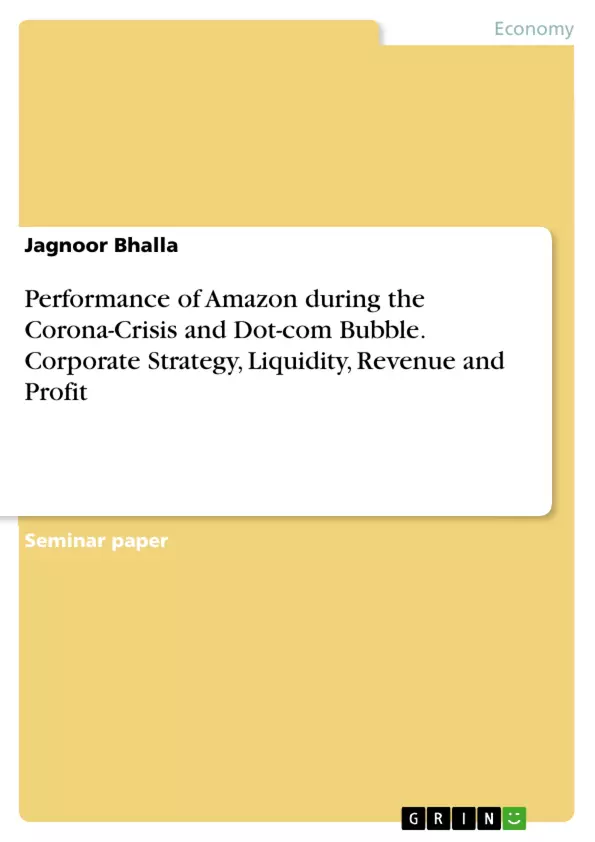This paper will examine the corporate success of Amazon.com, Inc. in times of the dot-com bubble compared to its performance in times of the corona-crisis. The comparison of the company during these financial crises will include corporate strategy, the company’s liquidity, revenue and profit. It will also analyse stock prices and the performance on the stock market, as well as the number of employees and their compensation as indicators for its financial situation and the company’s success.
Looking at the global economy, it is clear to see that financial crises are occurring from time to time, challenging companies in many ways to innovate and find solutions and get through financially instable times with minimal losses. There are also different types of crises which are weakening especially certain economic sectors.
The internet-crisis and the corona-crisis both had an immense impact on the financial market and the business world. Considering these two crises which are very different, or almost contradictory to each other, it seems to be interesting to compare the performance of an internet company, which began as one of these dot-com startups during the internet crisis, but is still innovative and successful to this day, even during the corona crisis.
Inhaltsverzeichnis (Table of Contents)
- 1 Introduction
- 2 Description and timeline of Amazon.com, Inc.
- 3 Comparison of Amazon's performance during both crises
- 3.1 Amazon's performance during the dot com era
- 3.1.1 Corporate strategy
- 3.1.2 Liquidity, revenue and profit
- 3.2 Amazon's performance during the corona crisis
- 3.2.1 Corporate strategy
- 3.2.2 Liquidity, revenue and profit
- 3.1 Amazon's performance during the dot com era
- 4 Conclusion
Zielsetzung und Themenschwerpunkte (Objectives and Key Themes)
This paper examines the corporate success of Amazon.com, Inc. in times of the dot com bubble compared to its performance in times of the corona-crisis. The comparison of the company during these financial crises will include corporate strategy, the company's liquidity, revenue and profit, stock prices and the performance on the stock market, and the number of employees and their compensation as indicators for its financial situation and the company's success.
- Performance of Amazon.com, Inc. during the dot com bubble
- Performance of Amazon.com, Inc. during the corona crisis
- Comparison of Amazon's corporate strategy during both crises
- Analysis of Amazon's liquidity, revenue, and profit during both crises
- Assessment of Amazon's stock performance during both crises
Zusammenfassung der Kapitel (Chapter Summaries)
Chapter 1: Introduction introduces the concept of financial crises and their impact on businesses, particularly highlighting the dot com bubble and the corona-crisis. It also presents Amazon.com, Inc. as a case study to analyze the company's performance during these crises.
Chapter 2: Description and timeline of Amazon.com, Inc. provides a detailed history of Amazon.com, Inc. from its founding in 1995 to its 25th anniversary in 2019. It highlights key milestones, including the company's IPO, the launch of Amazon Web Services, the acquisition of Whole Foods Markets, and the growth in employee numbers.
Chapter 3.1: Amazon's performance during the dot com era explores the company's corporate strategy, liquidity, revenue, and profit during the internet crisis. It analyzes how Amazon utilized its cash conversion cycle and managed to expand its business despite the economic challenges. The chapter also examines the growth in Amazon's revenue and the factors contributing to it.
Schlüsselwörter (Keywords)
The paper focuses on the performance of Amazon.com, Inc. during the dot com bubble and the corona-crisis. Key terms include corporate strategy, liquidity, revenue, profit, stock prices, employee compensation, cash conversion cycle, and market leadership. The analysis also examines the company's expansion, investments, and customer obsession.
- Quote paper
- Jagnoor Bhalla (Author), 2020, Performance of Amazon during the Corona-Crisis and Dot-com Bubble. Corporate Strategy, Liquidity, Revenue and Profit, Munich, GRIN Verlag, https://www.grin.com/document/1000556



